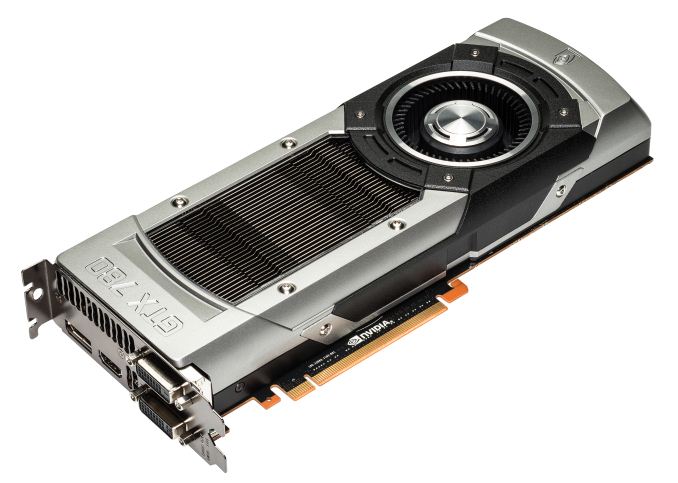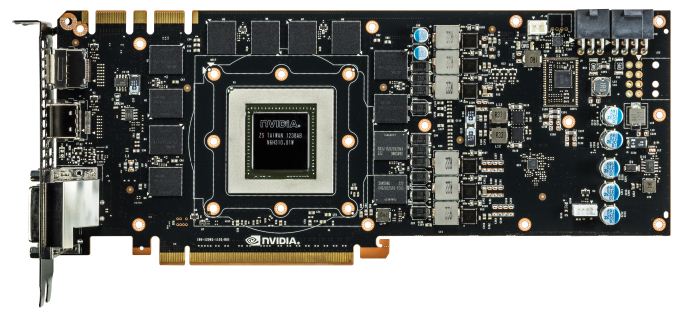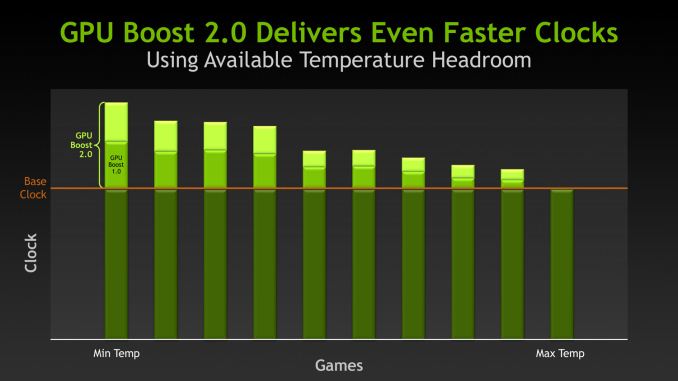NVIDIA GeForce GTX 780 Review: The New High End
by Ryan Smith on May 23, 2013 9:00 AM ESTMeet The GeForce GTX 780
As we previously mentioned, the GTX 780 is very much a Titan Mini in a number of ways. This goes for not only the architecture, features, and performance, but as it turns out it will be the case for the design too. For the reference GTX 780 NVIDIA will be straight-up reusing the GTX Titan’s board design, from the PCB to the cooler, and everything in between.
As a result the reference GTX 780 inherits all of the great things about the GTX Titan’s design. We won’t go into significant detail here – please read our GTX Titan review for a full breakdown and analysis of Titan’s design – but in summary this means we’re looking at a very well built blower design almost entirely constructed out of metal. GTX 780 is a 10.5” long card composed of a cast aluminum housing, a nickel-tipped heatsink, an aluminum baseplate, and a vapor chamber providing heat transfer between the GPU and the heatsink. The end result is that the reference GTX 780 like Titan before it is an extremely quiet card despite the fact that it’s a 250W blower design, while it also maintains the solid feel and eye-catching design of GTX Titan.
Drilling down, the PCB is also a re-use from Titan. It’s the same GK110 GPU mounted on the same PCB with the same 6+2 phase power design. This is part of the reason that GTX 780 has the same TDP as GTX Titan, while at the same time giving GTX 780 as much or more TDP headroom than Titan itself. Using the same PCB also means that GTX 780 has the same 6pin + 8pin power requirement and the same display I/O configuration of 2x DL-DVI, 1x HDMI, 1x DisplayPort 1.2.
Also being carried over from Titan is GPU Boost 2.0, which was first introduced there and has since been added to additional products (many GeForce 700M products already have it). GPU Boost is essentially a further min-maxed turbo scheme that more closely takes into account temperatures and GPU leakage characteristics to determine what boost bins can be used while staying below TDP. It’s more temperature dependent than the original GPU Boost and as a result more variable, but in cooler situations it allows tapping into that thermal headroom to hit higher clockspeeds and greater performance, TDP allowing. At the same time this means GTX 780 also gains GPU Boost 2.0’s temperature target functionality, which allows users to cap boost by temperature as well as TDP. As with Titan this limit is 80C by default, with the idea being that adjusting the limit is a proxy for adjusting the performance of the card and the amount of noise it generates.



















155 Comments
View All Comments
Finally - Thursday, May 23, 2013 - link
The GTX770 is a GTX680 with a different BIOS.Degong330 - Thursday, May 23, 2013 - link
Amused to see blind fanboy comments=PaulRod - Friday, May 24, 2013 - link
Well it is... slightly tweaked core, new bios, slightly improved performance... only worth buying if you're still on a 500/6000 series card or older.YukaKun - Friday, May 24, 2013 - link
Actually, it is true... At least, for the curent PCB GTX680'sCheers!
Ninjawithagun - Monday, May 27, 2013 - link
No, Finally is correct - the GTX 770 really is a GTX680 with a different BIOS! Unfortunately, there is no way to flash an existing GTX680 to a GTX770, in spite of early reports that such a capability existed. It was found out that in fact, the BIOS that was used to flash a GTX680 to a GTX770 was in fact a fake. The BIOS was a modified GTX680 BIOS made to look as if it were a GTX770 BIOS. Confused yet? lol The bottom line is that the only difference between a GTX680 and GTX770 is the clock speeds. The GTX770 comes in at around 11-12% faster clock speeds and as such is about that much faster in frame rate rendering in games. So if you already own one or more GTX680s, it is definitely NOT worth upgrading to a GTX770!An00bis - Friday, May 31, 2013 - link
this reminds me of the 7870, differences of under 10%, about 5% clock to clock compared to a 7850 that can OC the same, and people still buy it even though it's like $50 or more expensive than a 7850, just because it comes with a 1ghz OC, compared to a 7850 that only comes at about 800mhz stock.DanNeely - Thursday, May 23, 2013 - link
The 770 is using a revised version of the chip. While we're unlikely to see a large improvement it should run slightly faster for the same TDP.Hrel - Friday, May 24, 2013 - link
500Machelios - Thursday, May 23, 2013 - link
Better value than Titan, but still very niche...I'd like to see what Nvidia and AMD can bring at $250 in their next gen cards
AssBall - Thursday, May 23, 2013 - link
Agreed. A good video card should cost about as much as a good CPU, or a good MB.